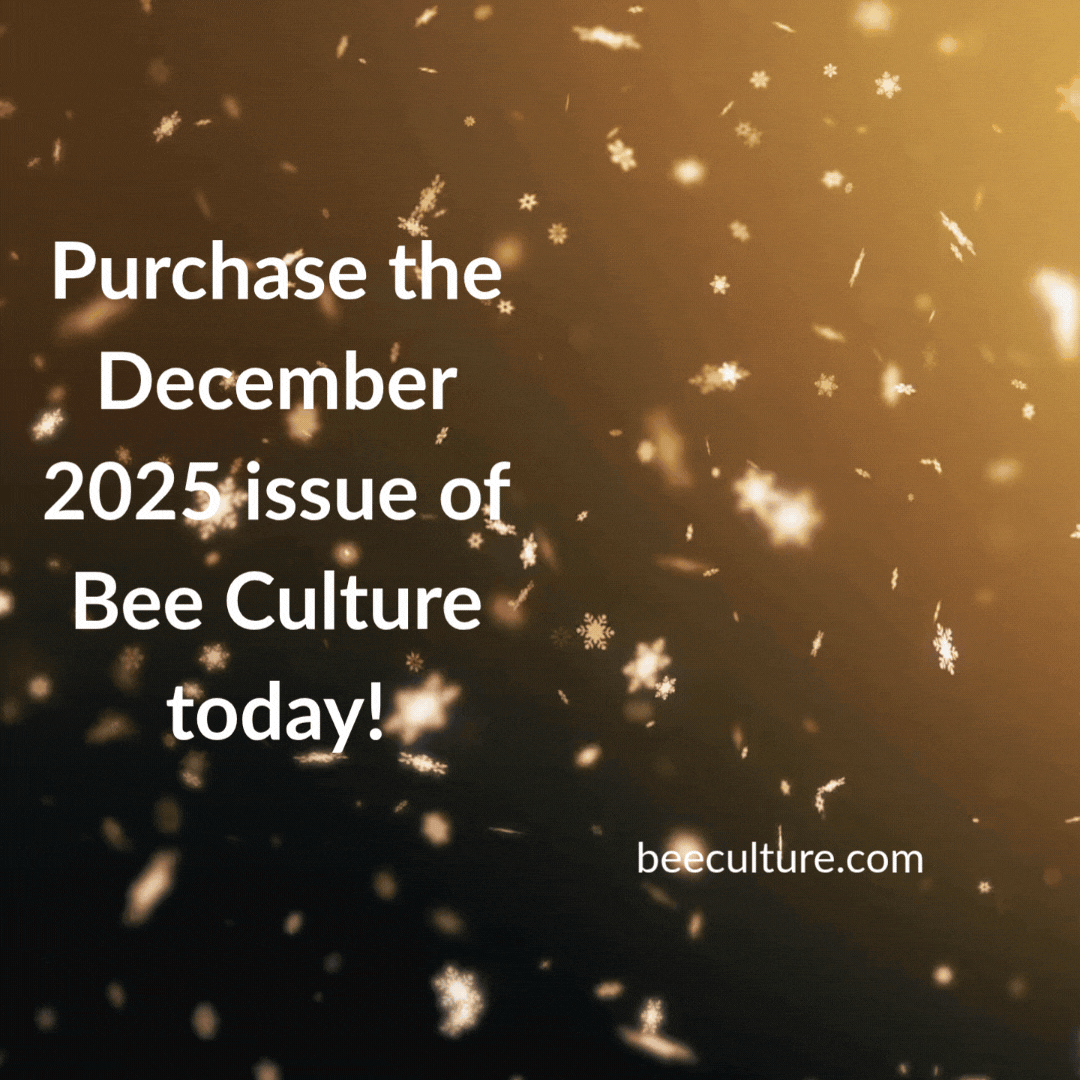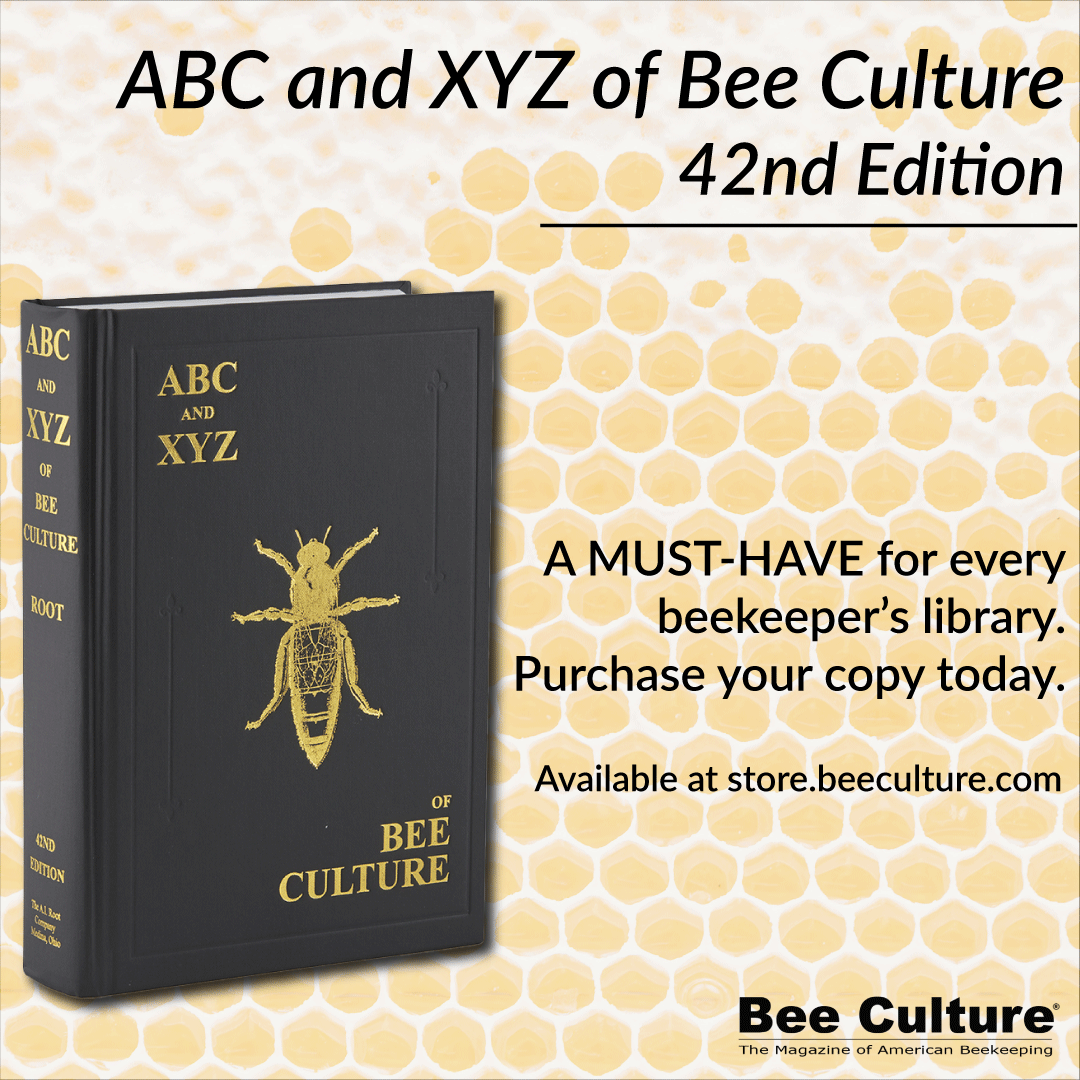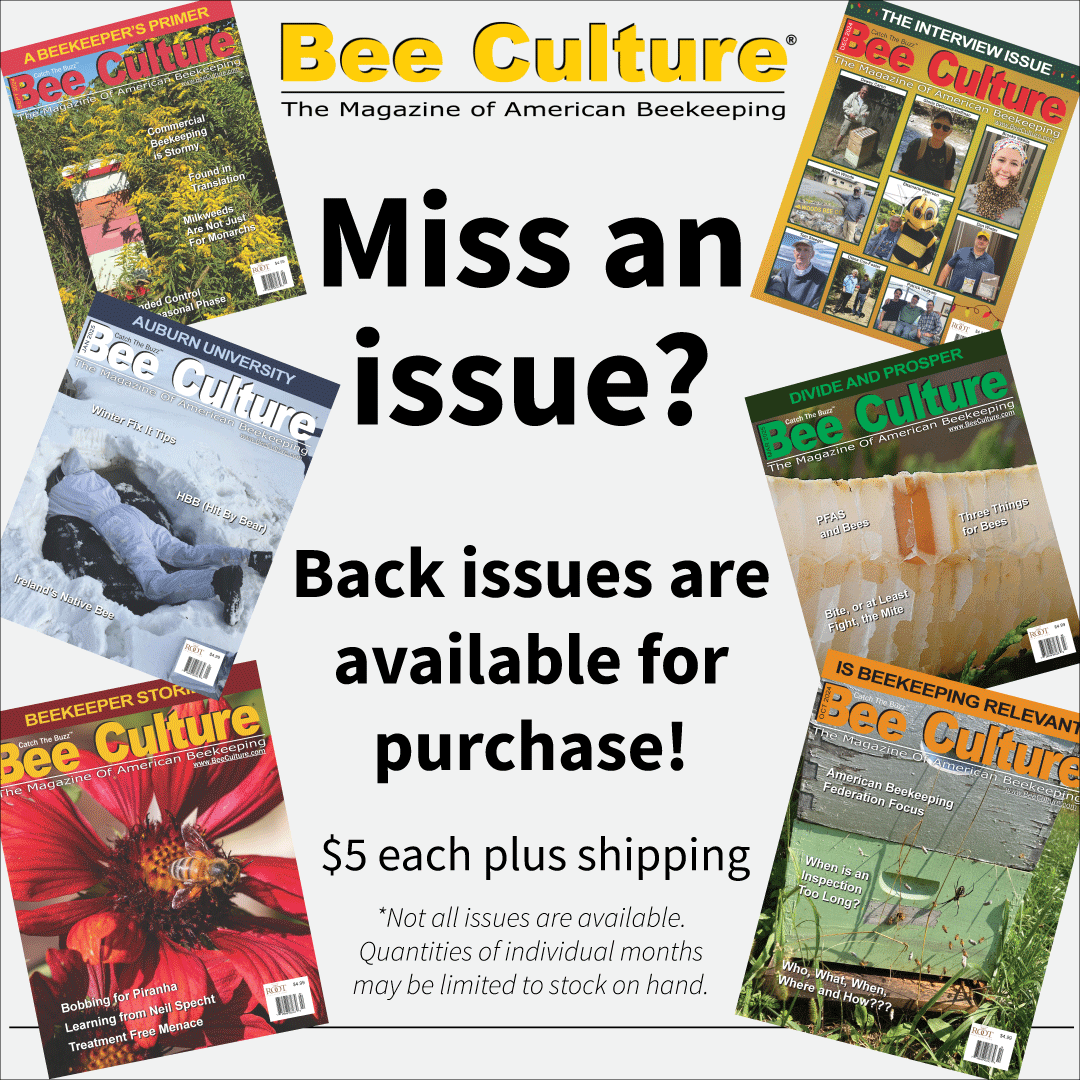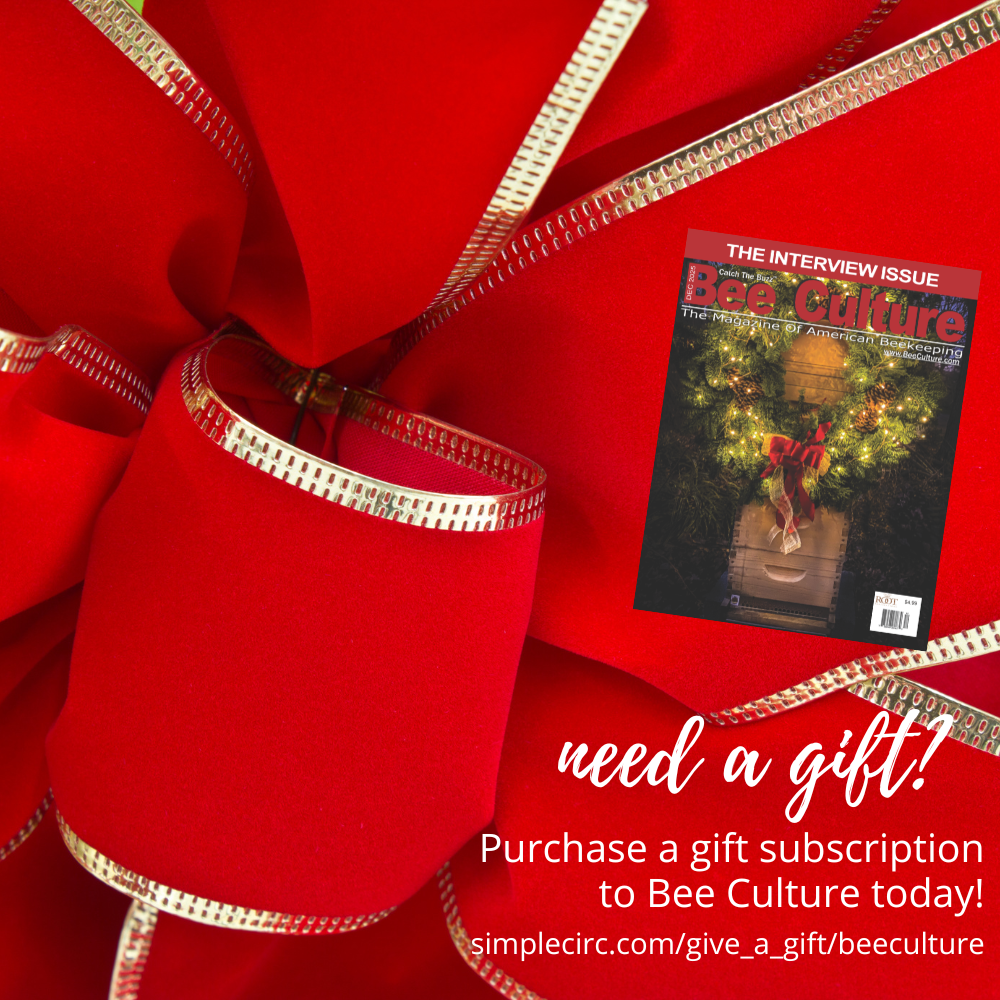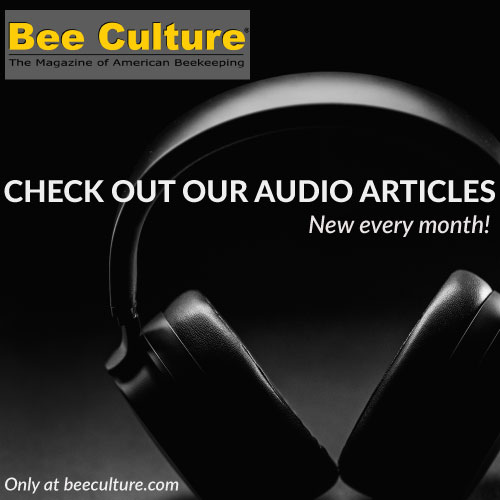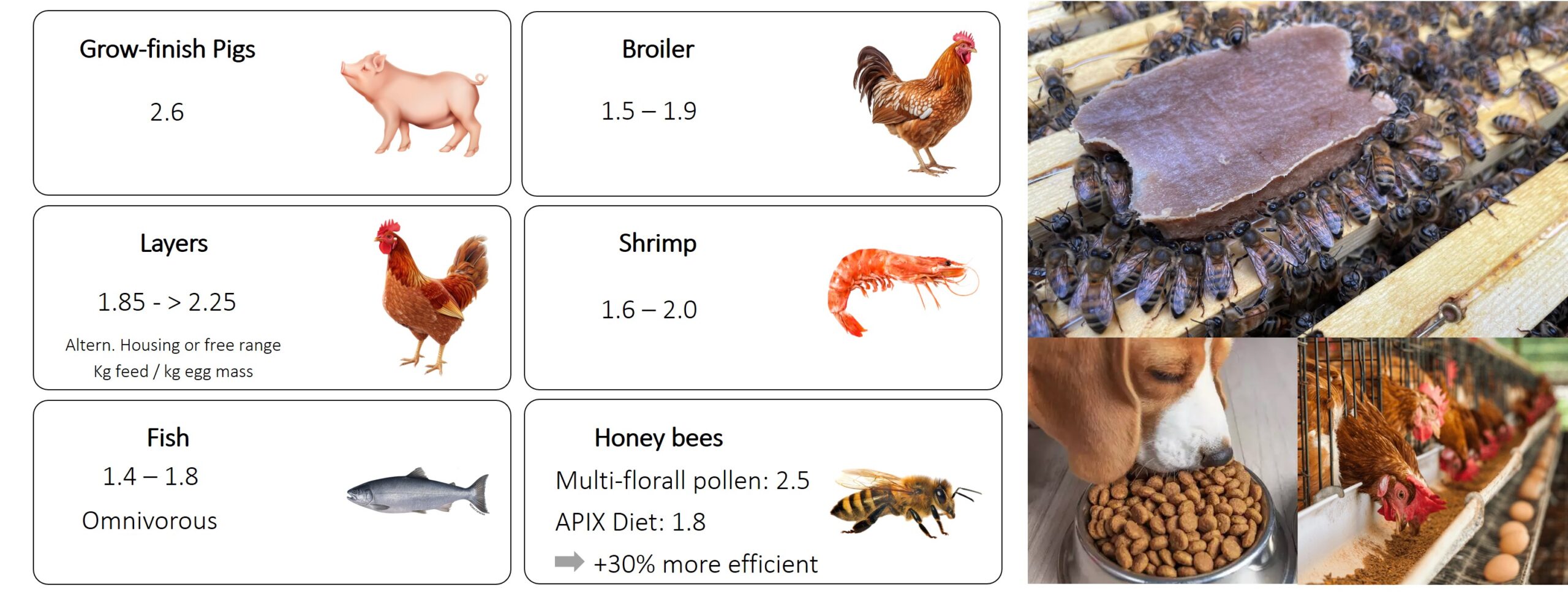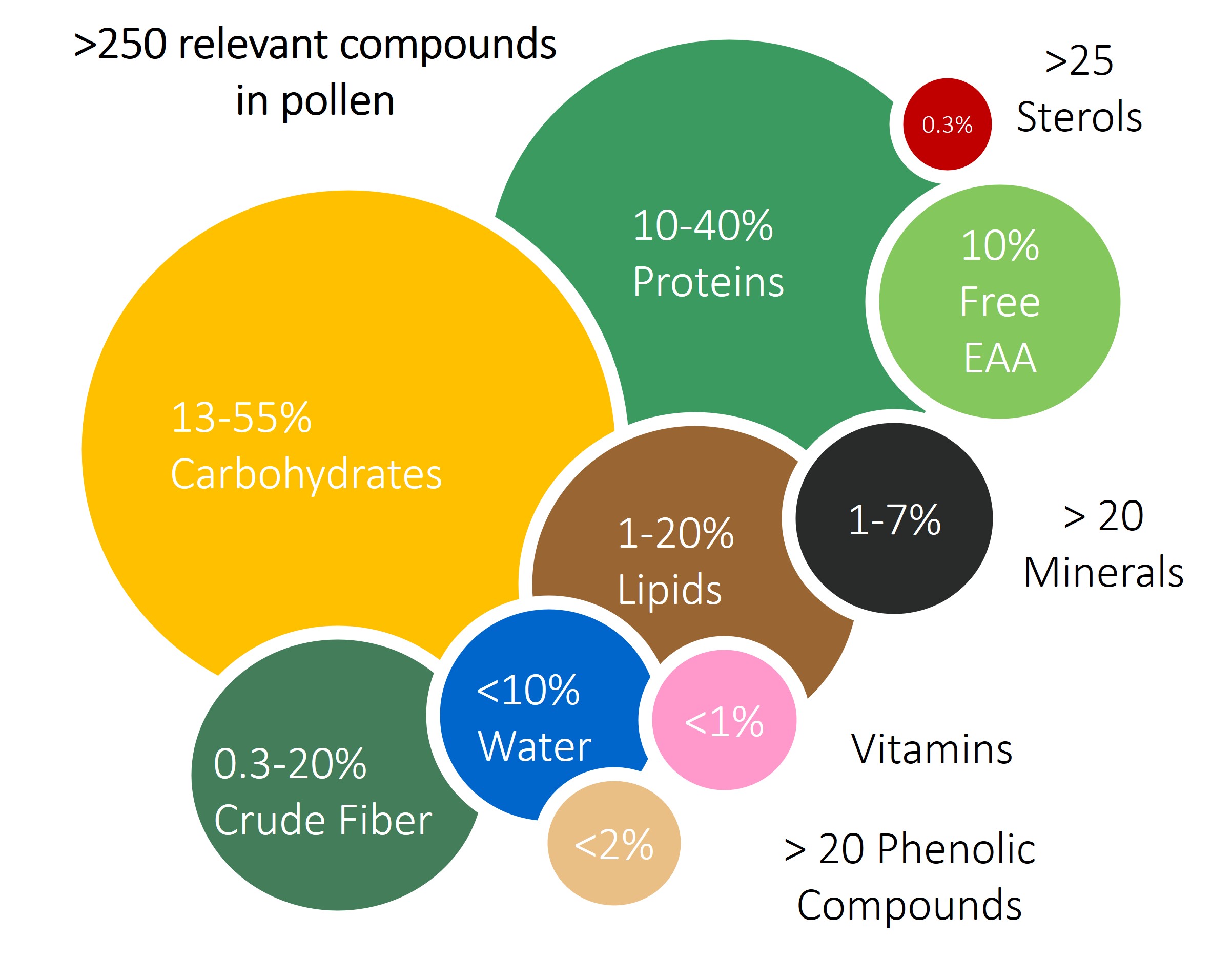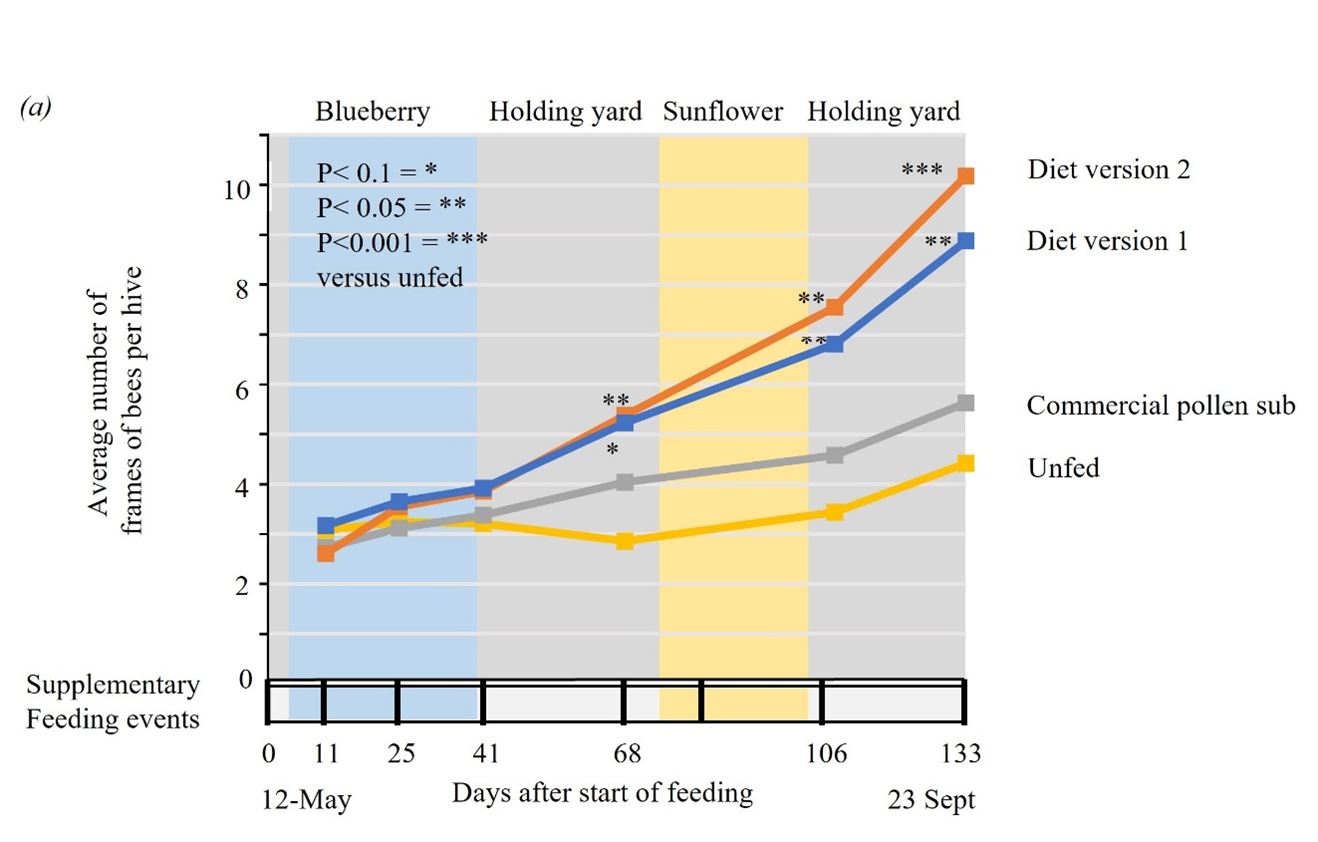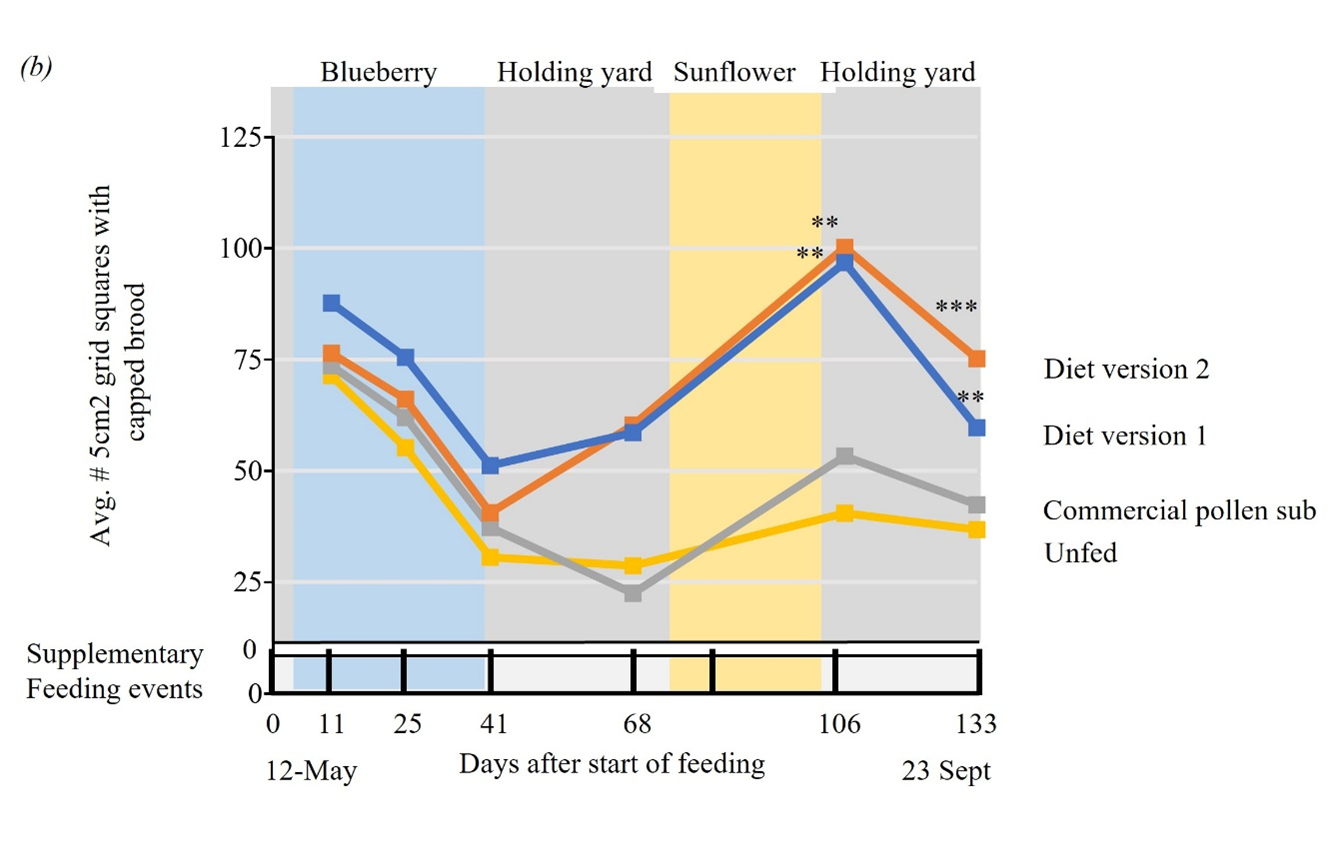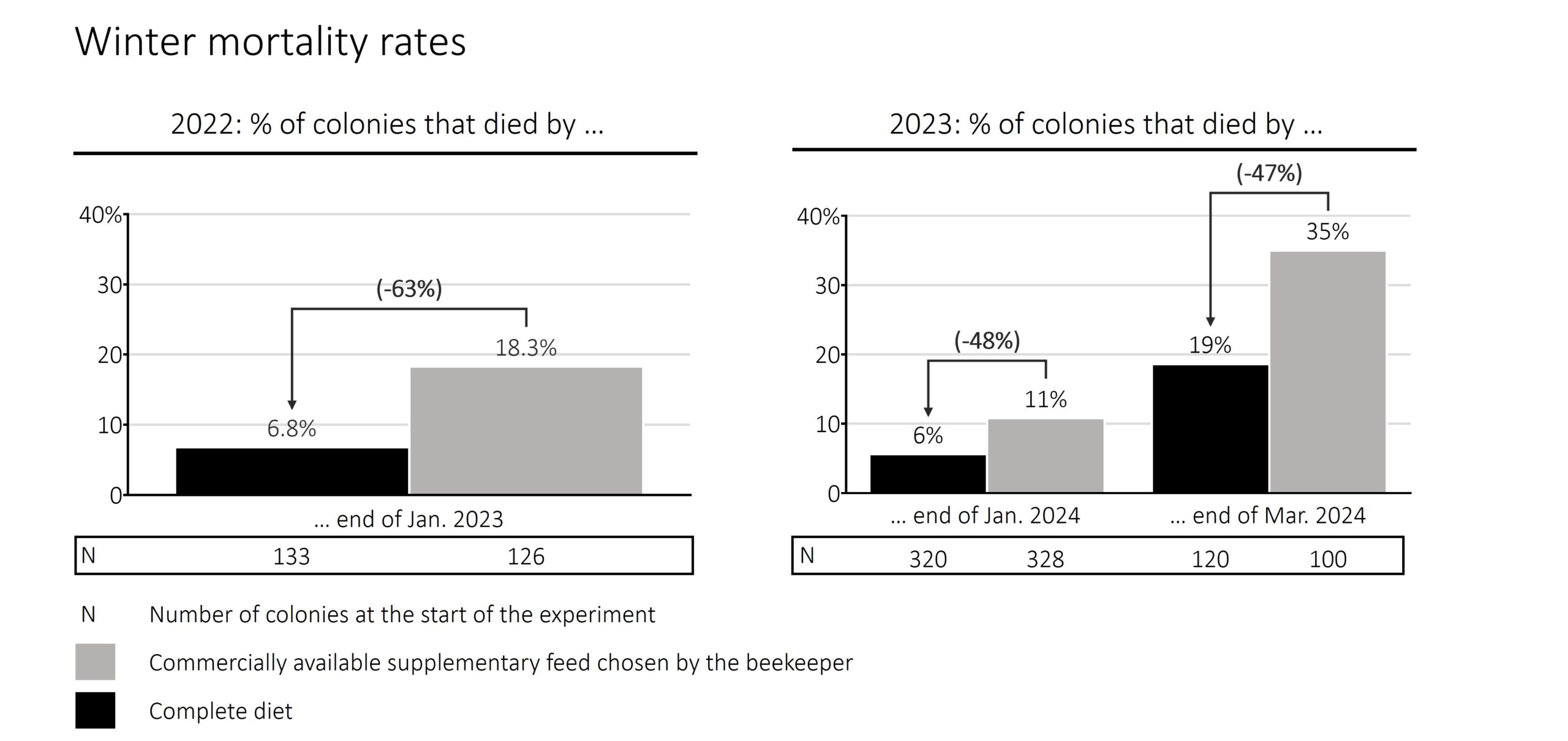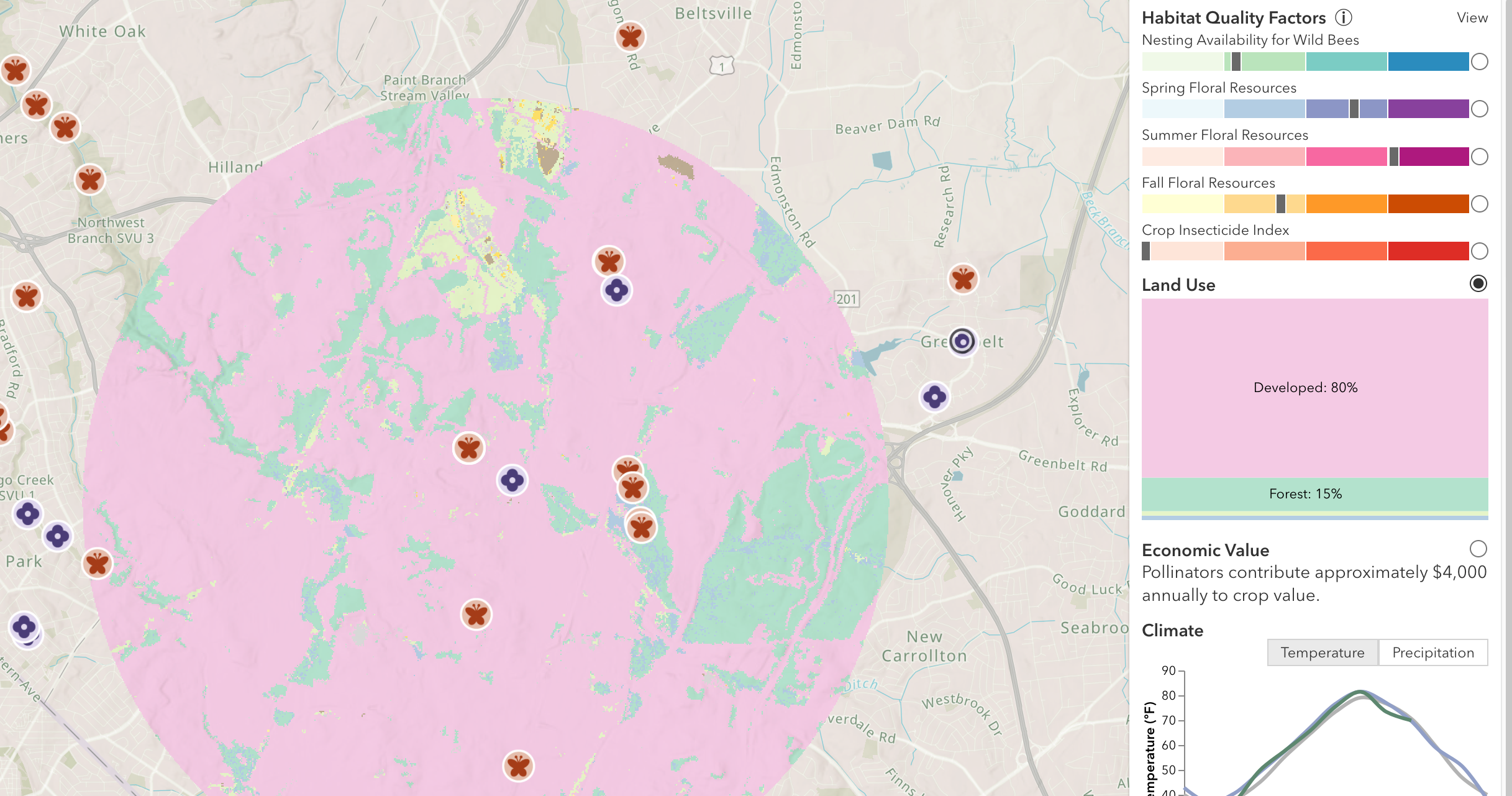A Complete Diet for Bees
Anne Marie Fauvel, Honey Bee Vitality, LLC & Dr. Brandon Hopkins,
Washington State University
Key takeaway
A recently published scientific paper describes an encouraging pollen replacing diet. However, there is more to the story as this diet has been tested extensively in a variety of scenarios relevant to U.S. beekeepers with exciting results. In the near future, beekeepers may have access to a feed that meets all known nutritional requirements of the honey bee. The implications could include healthier colonies, more reliable pollination services, and a tangible reduction in overwintering losses.
Introduction/Background
Honey bees are the backbone of modern agriculture, yet they are the only major livestock species without access to a complete, scientifically formulated diet. As beekeepers face increasing colony losses, shrinking forage and high-stress pollination demands, nutritional deficiencies have emerged as critical factors in declining colony health and productivity. Until now, supplemental feeds have fallen short of meeting bees’ full dietary needs. However, new large scale, science backed research is changing that. For the first time, a nutritionally complete, pollen-replacing diet has been made that keeps honey bee colonies alive and productive without any access to natural pollen. Further, extensive field tests of this diet have shown measurable benefits in survival, brood production and pollination strength.
Nutrition in Other Livestock and Agricultural Sectors
If you own a dog, cat, chickens, horses — or even a goldfish — you can visit your local feed store and find a wide selection of complete kibble and formulated diets. These diets provide all the essential nutrients an animal needs to thrive, without additional supplements. Feed science has advanced to the point where we even have metrics that measure how efficiently animals convert feed into products like meat, milk, eggs or offspring (feed conversion ratios, or FCRs).
Unfortunately for beekeepers, such a complete diet did not exist. The Feed Conversion Ratio is defined as the number of lbs. of feed required to make 1 lb. of livestock. The lower the FCR, the more efficient the feed is converted into livestock. This has become a key management tool in livestock nutrition management and is now in place for honey bees.
The Science of Honey Bee Nutrition
It is common knowledge that honey bees need nectar (carbohydrates for energy) and pollen (proteins for growth and development), but the understanding of the micronutrients bees need remains incomplete. Research suggests that vitamins and trace minerals in pollen are important, and recent studies highlight the crucial role of sterols. Sterols are known to be essential for honey bee development, health, and longevity. Most plant pollens lack one or more of the nutrients bees require. Ideally, honey bees would forage on a diverse array of flowers to meet their needs, but today’s large scale industrialized agriculture offers little diversity in the landscape.
Recent Advancements in Bee Nutrition – The Role of Isofucosterol
A recent study published in the Proceedings of the Royal Society B: Biological Sciences, April 16, 2025, (which we co-authored – https://doi.org/10.1098/rspb.2024.3078) demonstrates that a nutritionally complete Pollen Replacing Feed for honey bees is achievable and that isofucosterol is an important nutrient for honey bees.
Nutrition research with honey bee colonies to discover and formulate pollen replacing feeds is complex and difficult. Using the knowledge gained by recent studies and from testing more than 10,000 combinations of ingredients over more than 10 years of research, APIX Biosciences scientists have developed a complete diet for honey bees that contains all the nutrients they require, avoids anti-nutrients and can be produced at scale. The feed conversion ratio of this feed is 30% better than multifloral pollen (Figure 1).
In a controlled experiment, APIX Biosciences NV placed honey bee colonies in enclosed tents (~290 sq. ft.) without access to natural pollen. Colonies received various diets, each lacking a different sterol. Colonies missing isofucosterol showed significantly reduced brood production and neuromuscular issues in adult bees. In contrast, colonies fed the complete diet maintained continuous brood production over six brood cycles (May to September), compared to just over two cycles with standard commercial diets before colonies stop brood production.
The New Diet Shows Promise in Real-World Conditions
The new diet has been tested in a variety of conditions relevant to beekeepers today. It was tested in greenhouses on honey bee colonies pollinating zucchini and cabbage seed crops — environments with limited forage availability. In a field trial in the United States the diet was fed to honey bee colonies while they were pollinating two crops known to present challenges for honey bees, namely blueberry and sunflower. Finally, a large number of U.S. honey bee colonies were fed the diet through two consecutive Winters with survival and colony strength assessed prior to as well as after almond pollination. These results were presented at the latest California State Beekeepers Association and American Honey Producers Association conferences by the authors.
The results of the greenhouse testing were positive. For both zucchini and cabbage seed crops, colony population sizes remained stable in the complete diet group, while the no-feed group declined by 50% for zucchinis and 42% for cabbage, while brood production remained steady with the complete diet, but declined by 42% and 32% respectively in the no-feed group (results presented at the latest California State Beekeepers Association and American Honey Producers Association conferences by the authors).
The exciting results in the greenhouse trials were confirmed by field trials in the United States. Beekeepers know that their bees thrive on some crops but do not do that well on others. Blueberry and sunflower are thought to be particularly stressful for bees and, so, were picked as challenging conditions to test the diet. We monitored 64 colonies split into four groups, one fed the complete diet version 1, one fed the complete diet version 2, one fed a pollen substitute currently available on the market and the last group remained unfed. The colonies were all established from new packages, sent to blueberry pollination, followed by a period in a holding yard and subsequently moved into sunflowers. Again, colony population (in frames of bees), and brood coverage were measured for each period. See results in Figure 3.
Colonies supplemented with the complete feed consistently outperformed those given current commercial pollen substitutes — especially during successive pollinations, like blueberry followed by sunflower.
The most extensive trials, both in number of colonies and in geographic diversity, were conducted over two consecutive Winter seasons in the U.S. to assess the impact of a complete diet on survival and colony strength for almond pollination. We studied 259 colonies in five locations in the Fall of 2022 and 648 colonies across nine California locations in Fall 2023. Colonies were split into two groups: one fed the complete diet, the other the commercially available supplementary feed chosen by the beekeeper. The combined results show that colonies fed the complete diet had 48–63% lower mortality over two years (see results in Figure 4). These improvements directly impacted the percentage of colonies ready for pollination and the resulting almond pollination revenue: not only did more colonies survive Winter, surviving colonies were also stronger, averaging one more frame of bees post-Winter and beyond the almond bloom.
Practical Applications & Future Implications
The introduction of a complete, scientifically formulated diet has the potential to change honey bee management. As available bee forage declines and environmental pressures intensify, it cannot be considered a luxury to provide managed honey bee colonies consistent, balanced nutrition. Providing optimal nutrition is standard practice for any other livestock. The research discussed here demonstrates that a truly complete diet not only sustains colonies through periods of stress but improves survival, brood production and pollination strength in ways current feed supplements cannot. It is also encouraging that positive results were consistently demonstrated across a variety of pollination conditions, geographies and successive years.
Bibliography
1.EW Nutrition (2023) Rising feed costs? Focus on the FCR, EW Nutrition. Available at: https://ew-nutrition.com/us/rising-feed-costs-focus-on-the-fcr/ (Accessed: 12 May 2025).
2.Bogaert Thierry, Reams Taylor, Maillet Isabelle, Kulhanek Kelly, Duyck Maarten, Eertmans Frank, Fauvel Anne Marie, Hopkins Brandon and Bogaert, Jan 2025. A nutritionally complete pollen-replacing diet protects honeybee colonies during stressful commercial pollination — requirement for isofucosterol Proc. R. Soc. B.29220243078 http://doi.org/10.1098/rspb.2024.3078.


